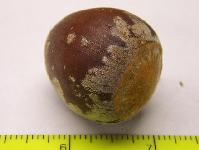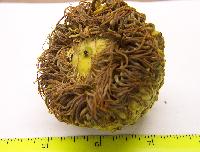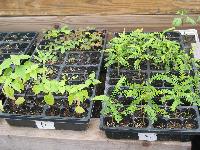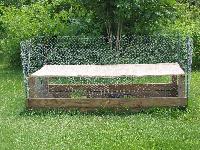
An
unexpected gift!
11/14/2003 @ 1200
|
| |
|
Got a great gift in the mail today.
Pete has been following this page, and
he sent me some bur oak acorns he has
collected from a couple of sites in
Pennsylvania. The acorns are huge! I
have never noticed these before. There
are all sorts of oaks around, especially
the ubiquitous white oak, but I have
always been looking for unusual types.
Now I have two types - these bur oaks,
and sawtooth oaks (see below).
Here are some photos of the
acorns; click on the photo for expando-shot. (Pete,
email
me if you want to trade some seeds.)


|
|
Planting
for next year
10/08/2003 @ 1000
|
| |
|
Let the fall planting begin! I
collected some horsechestnuts and
sawtooth oak acorns this week. I have
never germinated these before. I have
buried these seeds in potting soil, and
have them in my outdoor tree container.
I will try to keep them moist all
winter.
|
|
Scouting
for seeds...
08/22/2003 @ 0930
|
| |
|
Now is the time to begin scouting for
the seeds you want to collect this fall.
Catalpa - the "cigar-bean"
seeds are green now and full sized.
Osage orange fruits are appearing; some
are on the ground already. Acorns are
beginning to fall for a few species;
ginkgo fruits are visible; redbud seeds
have been visible for months now, but
are now full size. As you travel around
be sure to notice the trees you want to
collect from - if you are like me, some
you don't even know what type of tree it
is yet, just that it looks cool. Next
time you can bring your tree book and go
for the identification.
|
|
Transplanting...
08/06/2003 @ 1330
|
| |
|
Transplanted the Goldenrain seedlings
today. Yield is 10 seedlings out of 18
seeds planted. Some of these
seedlings are small due to late
germination, with the roots not quite
filling the planting cup. More rain the
last few days. A surprise - two more
ginkgoes germinated - I thought they
were done for the year.

|
|
Transplanting
continues...
08/04/2003 @ 1300
|
| |
|
Transplanting continues. Moved the
Osage Orange trees into 4" pots; 17
of 18 germinated. Checked the ginkgo
seedlings: of 60 planted, only 8
germinated. Dug out several of the
remaining seeds and found them rotted
away. I definitely need to work with
these more, or maybe this is the normal
germination rate. The weather continues
to be much wetter than usual, and a
little cooler.
|
|
Transplanting
begins
07/21/2003 @ 1430
|
| |
|
Began transplanting today. The
Kentucky Coffeetree and the Catalpas are
all ready to repot. The germination rate
for the catalpas is 100%, as usual.
These are the easiest trees to grow -
just stick the seeds in the dirt and
walk away. The Coffeetree seeds require
a little more work - see their page.
|
|
Quicker
Ginkgo germination
07/14/2003 @ 1300
|
| |
|
Two of the ginkgo seeds in the 5th
tray (from the 3rd planting day) have
germinated. This was on 06/16, so just
under a month. I scratched these seeds
with a hacksaw - maybe this helped. Or
it could be the warmer weather.
|
|
Finally!
Some more germination
07/11/2003 @ 1400
|
| |
|
Finally, some more germination. A 5th
ginkgo has germinated, and is just
poking up through the soil. Also, I have
1 redbud (Tray 1, Row 8) and 2 hornbeams
(Tray 1, Rows 10 & 11) seedlings.
This is 60 days or so - I don't know if
this is normal for these, or just due to
the wet cold spring. The weather the
last 2 weeks has been hot and sunny,
with a little rain.
|
|
The
Wet Summer
06/20/2003 @ 1000
|
| |
|
Checking the Kentucky Coffeetree
seedlings, only 5 of the 12 germinated.
The other 7 seeds rotted away, probably
due to the wet conditions. Also, some of
these pods were picked from the ground
and definitely were weathered a little.
Last year all the pods were either
knocked out of trees or picked up fresh
from the ground. I scarified 7 more
seeds with a hacksaw and planted them in
the tray.
|
|
New
Trees
06/17/2003 @ 1200
|
| |
|
Finally, some of the ginkgo seeds
have germinated. I had given up on this
entire tray (Tray A), but while checking
it today I found one shoot from a
ginkgo, and a partially uncovered seed
that had cracked open. This is 40 days
after planting. It will be interesting
to see if the scarified seeds planted
yesterday will germinate more quickly.
|
|
Planting
Day 3
06/16/2003 @ 1200
|
| |
|
The third tray of seeds included 2
types of seeds that (as of 06/16/03)
failed to germinate:
-
Ginkgo (ginkgo biloba) - these
seeds were ordered over the
Internet. I bought pods instead of
cleaned seeds. The seeds were
scarified before planting by using a
hacksaw to cut into the seed. Some
of the seeds were just scraped
lightly, while some were cut deeply.
-
American Hornbeam (carpinus
carolinia) - these seeds I collected
from Brandywine Park, just across
from my house. These seeds were
scarified by rubbing across a rather
coarse metal file that we have here
in our shop.
Here is the diagram of the Day
3 planting tray. Be sure to see
the page for each individual seed type
to learn more.
|
|
Back
from Europe!
06/16/2003 @ 1215
|
| |
|
Back from visiting Vienna, Slovakia,
and Prague. Lots of hiking, a nice climb
of the highest peak in Slovakia, and
walks through some very pretty cities.
Best of all, lots of "pivo"
(Slovakian for beer). Here
is the best picture from the trip, me
checking out the workings of a common
farm implement.
While I was gone there was about a
foot of rain, and only 2 days of sun.
With all the rain the planters were a
little flooded, but Bob made a rain
cover that kept them relatively
dry.
Tray A: no germination (the ginkgoes,
redbuds, and hornbeams). I'm hoping that
now that the sun is out and things are
warming up they will start to go.
Tray B: Most of the Kentucky
Coffeetree seeds have germinated, as
well as the Scholar trees and the
Goldenrain trees. The catalpa seeds are
all doing well, as usual. By the way,
the catalpas I grew last year and
planted around the property are doing
very well, even the ones that were
nipped off by our resident deer herd
last fall.
Tray C: Nothing from the Virgin
Islands Honey Locust, probably due to
the cool temperatures. All of the
thorned honey locusts, and most of the
smooth honey locusts, are up, as well as
most of the osage orange.
Tray D: 2 of the "Mystery
Seeds" are up, though wilted. Not
enough leaves to identify these yet.
Several mimosas are up, while the
paulownia and "mystery cherry"
are doing nothing. The catalpas in this
tray are up and thriving.
|
|
Last
report for a while...
05/30/2003 @ 1215
|
| |
|
I'm off to Europe for 2 weeks, so
this is the last progress report for a
while. The sun is out today, getting
very bright. I lost a few seedlings last
year to the sun, so this year I have
built a sun shade of burlap. The trays
are going into the planter box, with the
anti-deer chicken wire, and the sun
shade. I have arranged for the seeds to
be watered while I am gone.
Nothing has sprouted in Tray A, very
disappointing. A few of the Goldenrain
seeds have sprouted, as well as the
Scholar tree. The catalpas are going
strong, as are the honey locusts.

|
|
Things
are Happening
05/27/2003 @ 1215
|
| |
|
After a very rainy and cool Memorial
Day weekend, things are finally
happening. One of the "mystery
seeds" is sprouted (D1D), and two
of the mimosas (D2A, D3B). Almost the
entire two rows of catalpas (D11 &
D12) are up. A Kentucky Coffeetree has
sprouted (B2B) and several of the other
seeds are open. Most of the honey
locusts are sprouted, both the thorned
and smooth (C11 & C12, C5 - C7). The
tray tops are off as of today, as
several of the sprouts are too tall.
Today is partly sunny, but the clouds
and rain are expected back tomorrow for
at least three days.
|
|
More
Life
05/22/2003 @ 1215
|
| |
|
Back from 2 days away, one sunny day
and yesterday rainy and cloudy. I kept
the trays covered to avoid the strong
sun on Tuesday, and the plastic tray
covers are on. The soil is not too wet,
just damp now. The weather looks gray
and cold (60F) for the next week. Some
more germination: B1B continues but no
leaves yet. The honey locusts are
starting to emerge: C7C, C11C, C11F,
C12A, and C12E. A possible sprout at
A6F, Eastern Redbud. I expect slow
germination given the cold weather.
|
|
First
Signs of Life
05/19/2003 @ 0815
|
| |
|
The first signs of life were spotted
this morning when I arrived for work. A
Kentucky Coffee Bean seed was sprouting
(location B 1 B), and several others
were starting to disturb the soil.
Nothing else is happening, but I moved
the seed trays back into the sun. There
should be 2 days of sun before the rain
starts again.
|
|
Planting
Day 2
05/09/2003 @ 1300
|
| |
|
The second tray of seeds included:
-
Virgin Islands "honey locust" -
these are seeds that I collected in
April in the Virgin Islands (and
smuggled through customs). The
trees resemble honey locust, with
extremely large pods containing many
multi-colored seeds. These probably
can't withstand the winters here,
but maybe they can be kept in pots.
I scarified these with a few swipes
from a hacksaw.
-
Wisteria - these seeds came from
a beautiful large vine growing at
Longwood gardens.
-
Honey Locust (...) - this is a
thorned variety, a large specimen of
which is growing at the bottom of
Augustine Cutoff. Scarified with a
hacksaw.
-
Osage Orange (maclura pomifera) - these I
collected from a tree growing near
Brandywine Park and the foot of
Augustine Cutoff. A huge tree, with
lots of fruit each year. These seeds
were a pain to harvest - I literally
had to tear several fruits apart
with my hands to collect just 20
seeds.
-
Honey Locust - this is a
thornless variety from a side street
near Christ Church off Rt. 100 near
Rt. 52 just north of Wilmington.
Scarified with a hacksaw.
-
Black and White mystery seeds - I
have no idea what these are, except
that I collected them sometime,
somewhere, in my wanderings. Stay
tuned for more info....
-
Silk tree, or mimosa (..) - from
the property where my plant is.
These trees appear to be very hardy,
considering the soil here is mostly
clay and landfill dumped over the
last 200 years. I planted some of
these last year, and they all have
lots of thorns.
-
Box Elder (acer ....) -
these grow around the property at my
plant. Every year we are swarmed by
box elder bugs, so if these trees
have anything to do with the bugs I
will probably get rid of them. But,
hey, they are seeds; let's give them
a try.
-
Mystery (cherry?) - these seeds I
found on a small tree in front of
Lower Friends school one day when I
was on my bike and taking a shortcut
through Alapocas. The fruits were
cherry-sized, but translucent and
juicy, almost like a grape, but
firmer.
-
Empress Tree (paulownia
(tomentosa(?))
- these grow wild all around my
plant, and all along the Christina
River where it joins the Brandywine.
The seeds are very small, and come
by the thousands in the pods of this
tree. These trees are grown as crops
(for lumber) in some parts of the
country, primarily the south, but
around here might be a nuisance
plant.
-
Catalpa - the same as #7,
previously described. I planted more
for my retree effort around my
plant.
Here is the diagram of the Day
2 planting trays. Be sure to see the
page for each individual seed type to
learn more.
|
|
Planting
Day 1
05/08/2003 @ 1200
|
| |
|
The first tray of seeds included:
-
Ginkgo (ginkgo biloba) - these
seeds were ordered over the
Internet. I bought pods instead of
cleaned seeds. These are stinky! I
can see why only male trees are
usually planted in cities. I wore
surgical gloves to handle these
babies. After a winter of sitting
the pods were slimy and the seeds
just popped loose. The seeds were
planted without any scarification.
-
Eastern Redbud
(cercis canadensis) - I
collected these seeds last fall from
the garden at Wilcastle Center. I
had about 30 pods, but not all
contained usable seeds, and my total
yield was 24 seeds.
-
American Hornbeam (carpinus
carolinia) - these seeds I collected
from Brandywine Park, just across
from my house. There are several
hornbeams in the park, but only this
one has seeds that are accessible
from the ground. Lots of seed pods,
each with a good seed.
-
Kentucky Coffeetree (gymnocladus
dioica) - these seeds are
incredibly tough and require
scarification. I have read that the
seeds can remain viable for up to 10
years. Last year I tried scoring the
shells with a triangular file, but
they were too hard. A hacksaw works,
but takes too long. The way I
finally came up with is to put the
seed lengthwise into a bench vise
and tighten up until the seed
"pops", i.e., the shell
breaks. This does not hurt the seed
if you are careful and go slow.
These seeds usually germinate within
10 or so days.
-
Scholar tree (saphora japonica) -
also known as "pagoda
tree" - these seeds were
collected just around the corner
from my house. Earlier this month
the entire row of these trees was
removed by the city - apparently the
residents complained about the mess
from the pods. Too bad, this summer
when the temperature hits 100 and
the sun beats down on their houses
they will think about this again.
-
Goldenrain tree (koelreuteria
paniculata) -
there are many of these trees
growing here in Wilmington. I
collected these from in front of
Zanzibar Blue nightclub.
-
Northern Catalpa - I love these
trees. Last year I was in Kansas for
a week in early June, and all the
small towns were planted with these
guys. They were all in bloom - some
of them must have been 100 feet
tall. Very pretty. I collected these
seeds from a house near Bancroft
Parkway.
Here is the diagram of the Day
1 planting trays. Be sure to
see the page for each individual seed
type to learn more.
|
|
Seed
Storage
05/07/2003 @ 1200
|
| |
|
Most guides to storing seeds
recommend the refrigerator for storing
over the winter. I have the advantage(?)
of working in an unheated plant, which
in Delaware means that the low
temperatures required for dormancy are
available without any additional
cooling. In fact, this past winter we
had several days where the pipes froze
and we had to spend part of the day
thawing them out.
|
|
|
|
|
 Welcome to "The 2003 Growing Season," the story
of the 2003 Trees from Seeds growing season. This column
will provide you with a regular update on the status of
this year's crop of tree seedlings.
Welcome to "The 2003 Growing Season," the story
of the 2003 Trees from Seeds growing season. This column
will provide you with a regular update on the status of
this year's crop of tree seedlings.
|
|
| |
|
Check out my RSS feed for your newsreader:
|
|